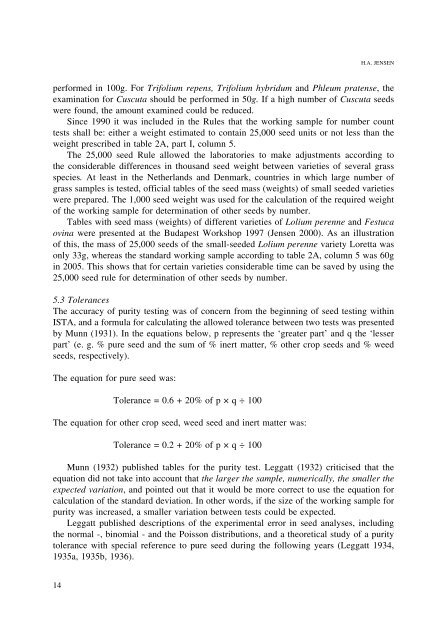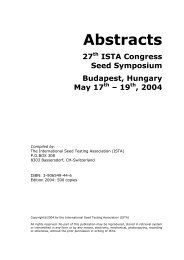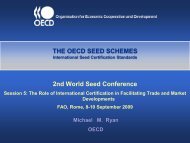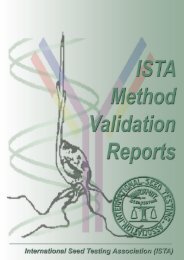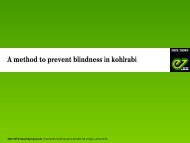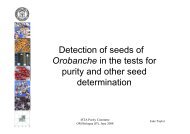Historical Paper - Volume 2 2008 - International Seed Testing ...
Historical Paper - Volume 2 2008 - International Seed Testing ...
Historical Paper - Volume 2 2008 - International Seed Testing ...
You also want an ePaper? Increase the reach of your titles
YUMPU automatically turns print PDFs into web optimized ePapers that Google loves.
H.A. JENSEN<br />
performed in 100g. For Trifolium repens, Trifolium hybridum and Phleum pratense, the<br />
examination for Cuscuta should be performed in 50g. If a high number of Cuscuta seeds<br />
were found, the amount examined could be reduced.<br />
Since 1990 it was included in the Rules that the working sample for number count<br />
tests shall be: either a weight estimated to contain 25,000 seed units or not less than the<br />
weight prescribed in table 2A, part I, column 5.<br />
The 25,000 seed Rule allowed the laboratories to make adjustments according to<br />
the considerable differences in thousand seed weight between varieties of several grass<br />
species. At least in the Netherlands and Denmark, countries in which large number of<br />
grass samples is tested, official tables of the seed mass (weights) of small seeded varieties<br />
were prepared. The 1,000 seed weight was used for the calculation of the required weight<br />
of the working sample for determination of other seeds by number.<br />
Tables with seed mass (weights) of different varieties of Lolium perenne and Festuca<br />
ovina were presented at the Budapest Workshop 1997 (Jensen 2000). As an illustration<br />
of this, the mass of 25,000 seeds of the small-seeded Lolium perenne variety Loretta was<br />
only 33g, whereas the standard working sample according to table 2A, column 5 was 60g<br />
in 2005. This shows that for certain varieties considerable time can be saved by using the<br />
25,000 seed rule for determination of other seeds by number.<br />
5.3 Tolerances<br />
The accuracy of purity testing was of concern from the beginning of seed testing within<br />
ISTA, and a formula for calculating the allowed tolerance between two tests was presented<br />
by Munn (1931). In the equations below, p represents the ‘greater part’ and q the ‘lesser<br />
part’ (e. g. % pure seed and the sum of % inert matter, % other crop seeds and % weed<br />
seeds, respectively).<br />
The equation for pure seed was:<br />
Tolerance = 0.6 + 20% of p × q ÷ 100<br />
The equation for other crop seed, weed seed and inert matter was:<br />
Tolerance = 0.2 + 20% of p × q ÷ 100<br />
Munn (1932) published tables for the purity test. Leggatt (1932) criticised that the<br />
equation did not take into account that the larger the sample, numerically, the smaller the<br />
expected variation, and pointed out that it would be more correct to use the equation for<br />
calculation of the standard deviation. In other words, if the size of the working sample for<br />
purity was increased, a smaller variation between tests could be expected.<br />
Leggatt published descriptions of the experimental error in seed analyses, including<br />
the normal -, binomial - and the Poisson distributions, and a theoretical study of a purity<br />
tolerance with special reference to pure seed during the following years (Leggatt 1934,<br />
1935a, 1935b, 1936).<br />
14


